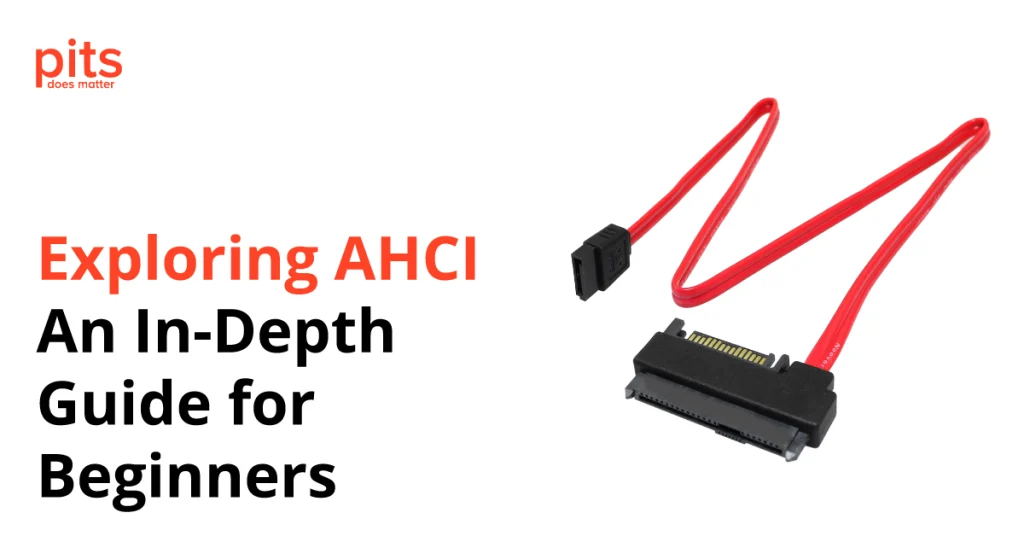In computer hardware and storage, the Advanced Host Controller Interface (AHCI) plays a pivotal role in ensuring effective communication between the operating system and storage devices. AHCI, short for Advanced Host Controller Interface, is a register-level interface that facilitates the utilisation of Serial ATA (SATA) controllers to link storage devices like hard drives and solid-state drives (SSDs) to the computer system. In this all-encompassing guide, we shall delve into the universe of AHCI, investigating its functionalities, advantages, and how to transition to AHCI mode for enhanced performance.
What is AHCI?
AHCI, or Advanced Host Controller Interface, is a technical specification that defines the operation of SATA drives and their controllers. It serves as an intermediary between the operating system and the SATA drive, enabling efficient data transfer, advanced features, and heightened performance. AHCI was introduced as a substitute for the older Integrated Drive Electronics (IDE) mode, which was prevalent in earlier systems.

AHCI allows the operating system to interact with SATA drives using the host controller interface. By furnishing a standard software interface, AHCI enables features such as native command queuing (NCQ), hot swapping, and hot plugging. NCQ optimises the sequence in which data is dispatched to and retrieved from the storage device, resulting in improved performance. Additionally, the capabilities of hot swapping and hot plugging permit the connection and disconnection of drives without necessitating a system restart.
Modes of Operation
AHCI offers two modes of operation: the legacy IDE mode and the AHCI mode. The legacy IDE mode emulates the behaviour of older IDE drives and provides compatibility with operating systems that do not support AHCI. However, this mode lacks the advanced features and performance enhancements of AHCI.
Conversely, AHCI mode unleashes the complete potential of SATA drives. It enables features like native command queuing, which improves data transfer speeds and reduces latency. AHCI mode is particularly advantageous for systems employing solid-state drives, as it maximises their performance.
Benefits of AHCI
- Enhanced Performance: AHCI unlocks the complete potential of SATA drives, enabling swifter data transfer rates, diminished latency, and improved overall system performance.
- Native Command Queuing (NCQ): AHCI’s NCQ feature optimizes the order in which data is retrieved from the drive, resulting in faster access to files and improved multitasking capabilities.
- Hot Swapping and Hot Plugging: AHCI allows for convenient and secure drive connection and disconnection without rebooting the system, providing flexibility and ease of use.
- Improved Compatibility: AHCI is supported by contemporary operating systems, including Windows Vista and subsequent versions, as well as various Linux distributions, rendering it a dependable and broadly compatible interface.

Switching to AHCI
To switch to AHCI mode, you need to follow these steps:
- Backup your data: Before making any modifications, it is crucial to back up your important files and data to ensure their safety.
- Enter BIOS/UEFI settings: Restart your computer and access the BIOS/UEFI settings by pressing the designated key during the startup process (usually displayed on the screen).
- Locate SATA settings: Navigate through the BIOS/UEFI settings to locate the SATA configuration options. The location and terminology might differ based on your motherboard manufacturer.
- Switch to AHCI: Once you locate the SATA settings, alter the mode from IDE or RAID to AHCI. Save the modifications and exit the BIOS/UEFI settings.
- Boot into the operating system: After rebooting the computer, it will boot into the operating system using AHCI mode.
AHCI, the Advanced Host Controller Interface, is a crucial element in contemporary computer systems that employ SATA drives. Its capacity to facilitate efficient communication between the operating system and storage devices allows for improved performance, advanced features, and heightened compatibility.
By understanding the basics of AHCI and making the switch from legacy IDE mode, users can unlock the full potential of their SATA drives and experience a significant boost in their system’s overall performance. Whether you are a beginner or a seasoned computer enthusiast, exploring AHCI is a crucial step toward optimizing your storage experience.
Frequently Asked Questions
What is AHCI, and why is it important?
AHCI stands for “Advanced Host Controller Interface.” It is a specification that defines the operation of SATA controllers, which are employed to link storage devices like HDDs and SSDs to a computer’s motherboard. AHCI is significant because it enables advanced features such as hot swapping, Native Command Queuing (NCQ), and improved performance, allowing for a superior overall storage experience.
How does AHCI differ from IDE mode?
IDE mode is an older emulation mode in which SATA controllers can function, while AHCI is the contemporary and preferred mode. AHCI provides several advantages over IDE mode, including support for hot swapping, NCQ for optimised data access, and enhanced performance for SATA drives, particularly SSDs. IDE mode lacks these advanced features and may restrict the performance and functionality of your storage devices.
Can I switch from IDE mode to AHCI without reinstalling my operating system?
Switching from IDE mode to AHCI typically requires some adjustments in the system’s BIOS/UEFI settings and may involve installing AHCI drivers or modifying registry settings in your operating system. While switching to AHCI without reinstalling the OS is feasible, it is advisable to back up your data and adhere to the appropriate steps for your specific operating system to ensure a seamless transition.
Which operating systems support AHCI?
AHCI is supported by most contemporary operating systems. Windows Vista and subsequent versions, Linux distributions, and macOS all inherently support AHCI. However, older operating systems might not have native support for AHCI. In such instances, you might need to install specific drivers or carry out additional steps to enable AHCI functionality.
Is AHCI required for using SSDs?
Although AHCI is not an absolute requirement for using SSDs, it is highly recommended. AHCI mode enables SSDs to fully leverage their capabilities, such as rapid data transfer rates, NCQ for optimised command execution, and TRIM support for sustaining performance over time. Switching to AHCI mode when employing an SSD can considerably enhance its performance and ensure that you extract the utmost benefit from your storage investment.
